Text

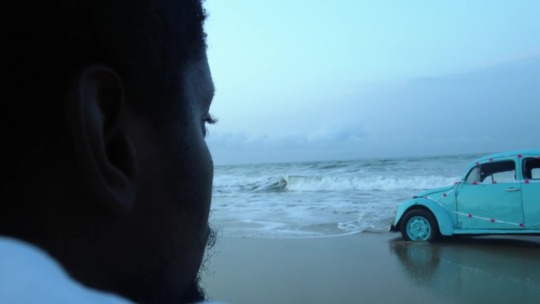
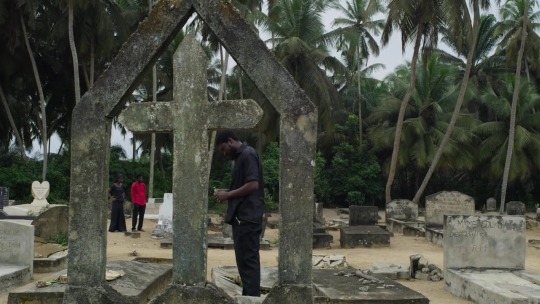
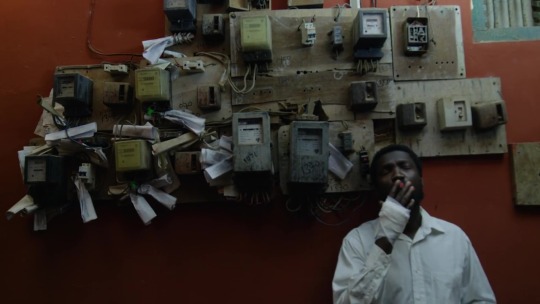



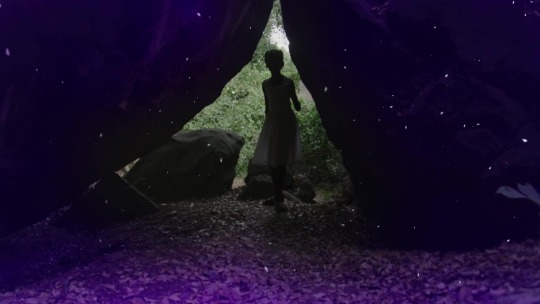


The Burial of Kojo (2018)
Director - Blitz Bazawule, Cinematography - Michael Fernandez
“My father Kojo had had the same recurring dream for 7 years. The dream where the sea swallows the earth and a raging fire burns. He never told anybody about this dream. He never told anyone it wasnt a dream at all. It was more like a memory. A tragic memory he could never forget. My father believed only the water could cleanse the past. So before I was born, he moved to a village surrounded by nothing but water. A village far, far away. This is where my story begins.
212 notes
·
View notes
Photo










Cinematography by: Łukasz Żal, PSC Cold War / Zimna wojna (2018)* Directed by Paweł Pawlikowski Aspect Ratio: 1.37 : 1
“We wanted the opening of the film to resemble a camera operator trying to record some folk musicians. Zula [Joanna Kulig] is a trigger for the camera so when she appears, the camera moves more. In Paris everything changes. The contrast gets higher, the vision becomes narrower and lenses are longer to separate Wiktor [Tomasz Kot] and Zula from the background. Back in Poland we wanted everything to become wider, they have become part of the landscape and it’s a magical time.”
“An important idea for this film was to always keep a high contrast in the production design because in Poland there is no sun in the winter. There was also an idea to treat this feature like a painting where you have a lot of details and structures so not to have a flat picture. A huge inspiration for me was the photography of Ralph Gibson. I was shooting for as much contrast as I could. We were using a lot of spotlights but also building a lot of negative fill, using large surfaces and a big butterfly.”
“We knew at the beginning that we wanted to use this particular ratio [1.37 : 1] because it worked quite well and resembles old cinema. It’s a great ratio to create not obvious compositions that are emotional and symbolic. You are also able to suggest what is beyond the frame.” — [x]
*Academy Award nominee for Best Cinematography in 2019
3K notes
·
View notes
Photo



The Departed (2006) By Martin Scorsese
10 reasons why this film ain’t working for me
Number one, casting was terrible. the only person who looked and felt like a real Boston mob or tough cop is Jack Nicholson. thank god for Mr Jack Nicholson. he’s the only good casting choice martin Scorsese made in this awful rip of of a film (yes i went there). another honourable mention is Leonardo DiCaprio for at least trying to get the role right. but the rest of the cast is a big huge disappointment, Matt Damon & Mark Wahlberg were a double fuck up. man they are too soft for the role even when they were cursing it felt they were reading it from a post card. and the sad thing they didn't event try !
i kept imagining what if young Robert De Niro & Ray Liotta were in it instead those guys were the real mob guys. I get that Scorsese probably want to pump some new bloods but at least cast people who can walk the walk and talk the talk ! i was so disappointed of the film what a waste of good story and good plotting. in fact i felt the urge to watch goodfellas right away to wash away all those feeling i have against Scorsese.
Number two to 10 is still bad casting ! everything els works out fine. the film would have been 10 times better if he made different casting choices !
#the departed#martin scorsese#The Departed (2006)#Jack Nicholson#Leonardo DiCaprio#Matt Damon#Mark Wahlberg
3 notes
·
View notes
Photo







Paradise: Hope (2013) by Ulrich Seidl
“the story of overweight thirteen-year-old Melanie and her first love. While her mother travels to Kenya ('Paradise: Love') and her aunt does missionary work ('Paradise: Faith'), Melanie spends her summer vacation at a strict diet camp for overweight adolescents. Between physical education and nutrition counseling, pillow fights and her first cigarette, Melanie falls in love with the camp director, a doctor forty years her senior. As the doctor struggles with the guilty nature of his desire, Melanie had imagined her paradise differently.” - IMDB
As i sink deeper into Ulrich Seidl’s trilogy i realise how genius he is. He has a similar provocateur sense to him like lars von trier and the playfullness of wes anderson but still very unique style of filmmaking.
Questions and questions thats all the film leaves you with. i’m still trying to wrap my head around it. is it a coming of age story of girl exploring her sexuality? is it about the absurdity of the teen strict diet camp? or is it about perverted middle aged man falling for a vulnerable chuppy teen? or is about chuppy teenager with dad issues? I don’t know but sure the film give you a sense your watching real characters going through real life situations where everything is in a grey area. once again Ulrich Seidl makes me question if i’m watching a documentary or a fiction film, casting non-profesional actors who gave fresh energy to the film, the camera always still and lingering with long takes it feels like it’s just punch of photographs put together to make a film, each shot is like a window still distant and objective.
one recurring element in this trilogy is Veronika Franz the co-writer of the script, she wrote the script togather with husband Ulrich Seidl, and i think she should get the credit too. sure Seidl style is unique but i cant feel that there’s a woman sensibility in the script. the notion of time in this trilogy is interesting, women wait, sit and wait and think before anything happens, wait for hope for love for faith. and i can see that through the characters and the progression of time.
#ulrich seidl#veronika franz#Paradise: Hope#paradies: hoffnung#paradise trilogy#films#movies#2013#Melanie Lenz#film#film reviews#movie#cinephile
1 note
·
View note
Photo





Y Tu Mamá También (2001) by Alfonso Cuarón
“In Mexico, two teenage boys and an attractive older woman embark on a road trip and learn a thing or two about life, friendship, sex, and each other.” IMBD
first of all the cinematography of Emmanuel Lubezki in this film is incredible, it wasn’t too planned like Children of men or too cheographed like Birdman. here its simple and using natural lighting most of the time. the camera has this voyeuristic feel to it. and it also complements the youthful energy of the character. i think thats my favourite film by Lubezki.
now lets talk about the character, as much as love seeing Diego Luna and Gael García Bernal together in one film, but i felt their youthful and genuine energy went to waste with unrealistic and unnecessary hyper sexual plot. and dont get me started on Maribel Verdú, i’m sure she’s a good actress but it was sad to see her go to waste with 1 dimensional character ! her whole purpose in the film to be the object of the male gaze for the two other men character and audience, and what pissed me the most that by the end of the film you find out that she died and that she was suffering from caner, just justify why she would sleep with two underaged men.
however i must admit there’s something special about this film, and i think it could be the mixture of the beautiful landscape of Mexican country side, lubezki’s camera and the youthful eneregy Diego Luna & gael garcia bernal brings to the film
4 notes
·
View notes
Photo
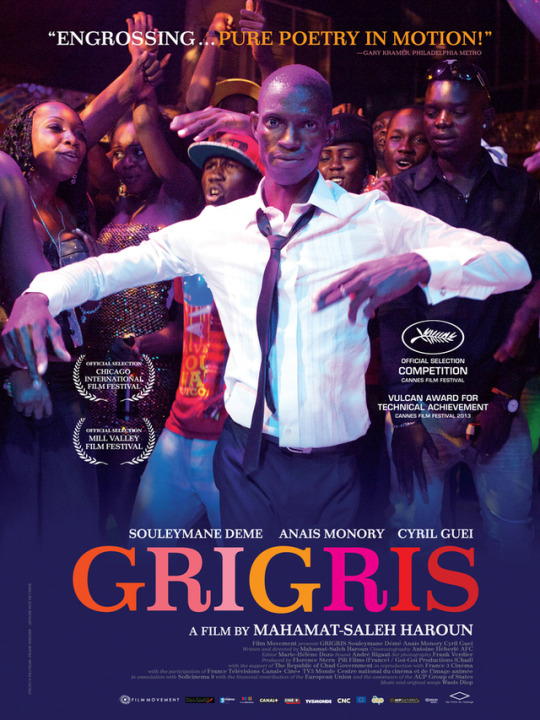


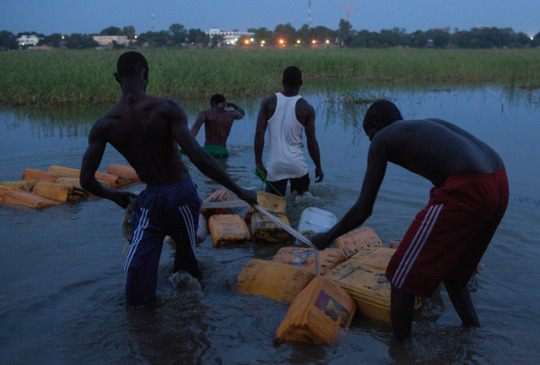



Grigris (2013) By Mahamat-Saleh Haroun
I’ve been interested to see the work of the Chadian director Mahamat-Saleh Haroun for while, and top of my list was Grigris (2013), Daratt (2006) and Abouna (2002). and i started with Grigris
Grigris starts with a promising plot, the charismatic dancer Souleymane Démé with a paralysed leg falls in love with a prostitute and joins a petrol traffickers gang to save his stepfather. but somehow the story falls short.
first of all lets start with element that got me a bit skeptic. i tried to move past the clique of the prostitute falling in love with the underdog but white cast a light skined mixed raced actress? played by the french actress Anaïs Monory. I’m sick of whitewashing in hollywood films but even in african films ! thats too much. and lets argue that the director wanted to cast a half-breed character to show she’s alienated by the society like Grigris feels still why not cast someone who looks like a Chadian half-breed, or at least someone who won’t stand out from all the cast you have.
another thing that sounded unrealistic to me is when the couple Grigris and mimi runaway from the local gang to hide in small village (of mostly women) where Mimi’s friend lives, there’s something unrealistic about how all the villagers accepts the new couple with open arms. and then when one of the gang member comes to look for Grigris they beat him to death and burn his car, a bit of a feminist twist but it’s too hard to swallow.
however on the other hand. i must admit that Mahamat- Saleh have a unique directional style. the silence in his film, how the character exchange long meaningful gaze at each other. the way he portrays Grigris as a real character rather then just exploit his disability. in fact he made me forget that i’m watching a character who suffers from a paralysed leg. and thats very rare to see in cinema as director usually love to exploit there characters to get the view sympathy. I love how the camera always keeps a safe distance from grigris leg and the only close ups on his face, as if saying focus on his story not on his disability.
The cinematography sucks you into the landscape of the film, Chadian streets, Chadian clubs, the houses the villagers. and it dignifies in away all character and locations. without judgement you don't feel you are watching poor characters living in poor slums. the cinematography simply invites you gently to the life of the characters. and i feel thats very rare in african cinema. i feel in lot of african films the camera sometimes judges the character or is too subjective always trying to force an impression about the characters and their environment. and I always feel the camera is like a foreign gaze or a western gaze judging the life of people. but not in Mahamat-Saleh Haroun films. in grigris the camera is neutral.
4 notes
·
View notes
Photo






Paradise: Love (2012) By Ulrich Seidl
“Teresa, a fifty-year-old Austrian mother, travels to the paradise of the beaches of Kenya, seeking out love from African boys. But she must confront the hard truth that on the beaches of Kenya, love is a business.” - IMBD
It’s very rarely that film makes me cringe like that for 2 hours ! the acting was brilliant and so realistic for a moment i forgot i was watching a fiction film, and the cinematography style helps enrich the since of authentic experience ! camera always still and watching from a safe distance you feel like you are watching a the characters from behind a curtains. and the dialogue ! how can anyone write such realistic and brutally honest dialogue it was for sure improvised as the amazing Margarete leads the non actors throughout the scene. her performance just elevates the films and brings authentic feel to every character she interacts with.
now lets talk about racism, it was very tricky ! at first you see the white women objectify the african men making fun of there smell and body physic in a nauseating way and you would think the director won’t be able to get away from such statements said by his characters but then the next minute you see Margarete walking in the beach and how those african men keep following her trying to sell her anything and exploiting her in a ugly way too. whos to blame the film makes you question that. who’s the antagonist? is it the middle aged white woman who tries to buy sex from younger african men because she can’t get someone to have sex with her in her country or is it those african men selling lies and there bodies for white older women because they live in poverty
the film sure makes you question everything and delivers a unique and authentic character study !
5 notes
·
View notes
Photo






Nobody Knows (2004) By Hirokazu Koreeda
“In a small Tokyo apartment, twelve-year-old Akira must care for his younger siblings after their mother leaves them and shows no sign of returning.” - IMBD
What a wonderfull film, it’s my second film by Koreeda, my first was after the storm. it feels like both films were shot in the same apartment.
where I dont know how to start, first of all i love how Koreeda established the places and kept repeating it until the end of the film i felt like i memorised the geography of where the film take places. the tiny apartment, the park next door, the large steps that leads to the main road, the supermarket where the main character Akira always goes to. the market streets. most of the film happen in these places.
second of all i love how Koreeda took the story from real events of a case of mother who abandoned her five underage children in Japan. but rather then doing what any filmmaker would do, which is dramatise the film, blame the mother and exploit the story to blame society and mothers. he could have easily fall into this trap, but he didn’t. instead we see the emotional development of the elder son Akira as he tries to take care of his 3 siblings while still trying to live his life.
I love the tone, at first it was very hard to sit through because of the slow pace, but once you continue watching it grows on you and it’s very rewarding. to see the kids normal life nothing is dramatised or exploited, one scene they play happily together and the next they are quietly trying to get over there hunger because they are out of money. some friends they make and others walk out of there lives. beautiful simple and minimalistic full of ups and downs and the closest thing you can see to life. no big events just normal everyday life situations.
1 note
·
View note
Photo






Elephant (2003) By Gus Van Sant.
The camera float effortlessly through a high school corridors, capturing glimpses of the life of teenagers. the pacing start very slow as Van Sant introduce the typical character you would find in every school. the troubled kid with alcoholic father, the ambitious photographer, the football player, the popular girls and the frustrated bullied pianist slash artist. the film takes an unexpected turn and ends with an unimaginable tragedy.
haven seen some of Van Sant’s work before its shocking how this film is nothing like his other work, dialogue is minimum and strictly practically, the characters are very reserved and natural, perhaps because most of the characters played by non-actors. the structure of the film is very interesting and loose. the editing is phenomenal and manages to deconstruct times in non-linar way, each character time line intersect at particular moment then comes back to that exact moment to pick up another storyline of that same moment. i’ve never seen that in a film before, its hard to describe it but it seems like each character going in circle and then two characters circle intersect creating different time lines within one present moment.. feeling lost me too go watch it and let me know how you feel about it.
One last thought the film reminds me of phenomenon called Sonder
Sonder n. the realization that each random passerby is living a life as vivid and complex as your own—populated with their own ambitions, friends, routines, worries and inherited craziness—an epic story that continues invisibly around you like an anthill sprawling deep underground, with elaborate passageways to thousands of other lives that you’ll never know existed, in which you might appear only once, as an extra sipping coffee in the background, as a blur of traffic passing on the highway, as a lighted window at dusk. The Dictionary of Obscure Sorrows
3 notes
·
View notes
Photo
What a fantastic film ! It's my first fatih akin experience. Very hip and funky
The premise is simple a guy tries to manage his failing restaurant and maintain a long distance relationship with his girlfriend who recently moved to China ..
The style of the film feel like a Hollywood film but the way muchbb better execution.. I haven't seen many German films bt I like how chilled Germans are i wonder if that's the case in real life ... I can imagine if the film was in US they would've tried so hard and ended up with self conscious with pushing moral lessons down your throat.
Also the music and the characters are so alive and refreshing ..







Soul Kitchen (2009)
84 notes
·
View notes
Photo


Happiness by Todd Solondz
the premise is simple, follows the life of 3 sisters and their search for love, connection and happiness. it was really intense and hard to sit through. specially the end when the pedophile father confess to his 11 years old kid about his crime that was the most intense scene i’ve seen in my life I had to skip it and this is coming from someone who saw A Serbian film and Salo and thought are both a master piece, I think the horrifying thing about the scene is that Todd Solondz wrote a real person, a loving father who cared for his kid and loves his wife but just happen to be sick.. and it felt like a real person not just a monster with no morals thats why it was horrible to see a real human being not so different from they want the same things we want. it’s horrifying cause makes you realise that we humans are all the same not so different from each other, we all have our “pluses and minuses”.
the film reminds me alot of Lars Von trier’s Nymphomaniac, actually now I think of it i bit Lars saw this film and borrow from it, both films deal with characters searching for human connection.. but now that i’ve seen Happiness i feel Nymphomaniac .. Solondz wrote characters that are more relatable and accessible then Von Trier self projected character.. I can’t believe i’m saying that even though Lars Von trier extreme films always fascinated me, how he push cinema to its limits but then again he gets too self indulged and make his films inaccessible.
one a last note, Philip Seymour Hoffman, Philip Seymour Hoffman, Philip Seymour Hoffman intense and original performance.
10 notes
·
View notes
Photo





Palindromes by Todd Solondz
I still can’t shake this film. I randomly came across this film while researching films about abortions (for a short script I’m working on) I came across this film. after reading a short synopsis that promises a film about a teenage struggling from unwanted pregnancy, parents force her to get an abortion and she runs away. i was half sold but after seeing an obsessed africana american girl on the cover i thought his could be interesting and could be similar to Lee Daniels’a Precious.
I can’t really describe it. it was bizzar and very unusual story but in a very refreshing way, SPOILER ALART AHEAD, I still can’t wrap my head around it. you got 8 different character from different age group playing the role of Aviva a thirteen years old girl, including two african american actresses. you got parents pushing Aviva to get an abortion resulting to her loosing her ability to bare children. then she runs away a bizzar foster house where a woman who takes care of unwanted kids by day and her husband plan to murder abortionist doctors by night. then she come across a lonely truck driver who ends up taking advantage of her but later on killing the doctor who operated the abortion surgery on her.
I can’t tell if Todd Solondz is a genius and a head of his time or pervert. he made me question everything from race, pedophilie, abortion and family values. I don’t I wish if someone can help me to better articulate what this film is about
1 note
·
View note
Photo




Wanderers of the Desert By Nacer Khemir
A Fairy tale about a teacher that arrives to a mysterious village, he comes to learn about the villages legends about buried treasure and a curse that makes young men wonder the desert aimlessly.
in many interviews Nacer Khemir talks about how he’s films are heavily influenced by stories of Arabian nights and 1001 nights, and here in his first feature film it’s very evident and manages to create his own fairy tale using classic arabic poetry & music and the desert in the backdrop. Like Pasolini’s mystical cycle Nacer uses production design, wardrobe and beautiful ancient ruins to intensify the our experience of the film, the minute the teacher set foot in the village everything seems beyond ordinary and nothing seems familiar, kids head shaved like Budda monks, men dressed in medieval cloth, women dressed in colourful kimono like outfits and their faces full of gypsy like tattoo nothing gives a clue of any cultural reference.
another thing i liked about the film is house they keep this sense of mysticism and most of things are alluded but never confirmed. and ive never seen the desert painted so beautiful in a film. I still cant get over the image of the unknown men walking between the dunes and the wind blowing sand so poetic and so symbolic.
there was time where I felt that the Shekhi’s daughter (played by actress Soufiane Makni) is inspired by Sofiko Chiaureli from the Colour of pomegranate (dir Sergei Parajanov) when she was playing the young Poet/ Ashiq and in many times i really felt that Nacer is inspired by Parajanov’s work, they both are heavily inspired by folks tale and their rural life , they both employ religion in a mystical way in their films and use symbolism from it, their both inspired by poetry for Nacer Khemir it was classic arabic poetry and for Parajanova it was Georgian poetry.
42 notes
·
View notes
Photo



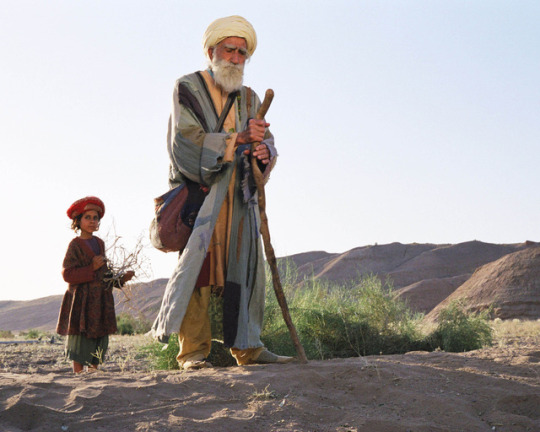

Bab'Aziz - The Prince That Contemplated His Soul (2005) by Nacer Khemir
What a truly magical film. the premise is simple an old man and his daughter travel through the desert looking for the meeting point of the dervish festival a meeting that happens only every 30 years where all devrish get together. then before you know it the film turns into a dream within a dream, stories within stories about prince and a man looking for his lover and other looking for his palace. the only way you can describe the film its a feels like a paulo coelho novels and with aesthetic of Pasolini and Rumi’s mysticism.
the film sure make experience the world of dervish that invisible world
23 notes
·
View notes















